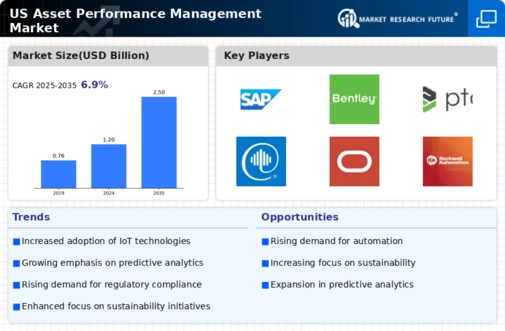Increased Focus on Data Security
Data security has emerged as a crucial driver in the asset performance-management market. With the rise of cyber threats, organizations are prioritizing the protection of sensitive asset data. This focus on security is prompting companies to invest in robust asset management solutions that incorporate advanced security features. The market is likely to see a significant increase in demand for solutions that offer encryption, access controls, and compliance with data protection regulations. As businesses recognize the potential risks associated with data breaches, investments in secure asset performance-management systems are expected to rise. This trend underscores the importance of data security in maintaining trust and integrity within the asset performance-management market.
Shift Towards Digital Transformation
Digital transformation is reshaping the asset performance-management market. Organizations are increasingly adopting digital tools and platforms to enhance their asset management processes. This shift is driven by the need for real-time data access and improved decision-making capabilities. The market is projected to grow as companies invest in cloud-based solutions and mobile applications that facilitate remote monitoring and management of assets. In fact, it is estimated that digital transformation initiatives could lead to a 15% increase in asset performance efficiency. This trend indicates a broader movement towards integrating digital technologies into traditional asset management practices, thereby driving growth in the asset performance-management market.
Growing Demand for Operational Efficiency
The quest for operational efficiency is a significant driver in the asset performance-management market. Organizations are increasingly focused on optimizing their operations to reduce costs and enhance productivity. This trend is evident as companies aim to minimize asset downtime and improve maintenance strategies. According to recent studies, businesses that implement effective asset performance-management strategies can achieve cost savings of up to 25%. This growing demand for efficiency is pushing organizations to adopt advanced asset management solutions that provide real-time insights and analytics. As a result, the asset performance-management market is expected to expand as companies prioritize operational excellence.
Regulatory Compliance and Risk Management
Regulatory compliance is a critical driver in the asset performance-management market. Organizations are compelled to adhere to stringent regulations regarding asset safety and environmental impact. Non-compliance can result in hefty fines, which can reach millions of dollars. As a result, companies are investing in asset performance-management solutions that ensure compliance with regulations such as OSHA and EPA standards. The market is likely to grow as firms seek to mitigate risks associated with asset management. In fact, compliance-related investments are expected to account for approximately 20% of total asset management expenditures in the coming years, highlighting the importance of regulatory adherence in the asset performance-management market.
Technological Advancements in Asset Management
The asset performance-management market is experiencing a surge due to rapid technological advancements. Innovations in software and hardware are enhancing the capabilities of asset management systems. For instance, the integration of artificial intelligence (AI) and machine learning (ML) is enabling predictive maintenance, which can reduce downtime by up to 30%. Furthermore, the market is projected to reach $10 billion by 2026, driven by these technological improvements. Companies are increasingly investing in advanced analytics tools to optimize asset utilization and performance. This trend indicates a shift towards data-driven decision-making, which is becoming essential for maintaining competitive advantage in the asset performance-management market.

























Leave a Comment